Drood

Next Thursday’s ‘Novel’ class (the final one, before reading week) is on Edwin Drood. As we all know, Dickens died before he was able to complete this novel, and I’d like the use the session to discuss this incompletion, and the larger questons of ‘endings’ and ‘closure’ in Dickens’s writing. (I’m sure I don’t need to add that ‘endings’ and ‘closure’ are not the same thing …)
The business of ‘finishing’ the story of Drood, in a narrative and a ‘whodunnit’ sense, has occupied people almost from as soon as Dickens died. Spirit mediums ‘completed’ the book aolmost immediately (The Mystery of Edwin Drood Complete. Part the Second, By the Spirit Pen of Charles Dickens, through a Medium 1870); and there have been various other ‘solutions’ and ‘full’ versions. Indeed, later this year, the BBC are going to broadcast a dramatisation with an ending supplied by Gwyneth Hughes. Wilkie Collins, Dickens’ friend and collaborator, was asked to finish the book in 1870 — as he wrote to an American newspaper, reacting to an article published by a certain Mr Barnes:
4th Dec. 1878.
My dear Sir,—I can only suppose that another false report of my having finished ‘Edwin Drood’ has been let afloat in America, I was asked to finish the story soon after Dickens’s death, and positively refused. Any assertion or newspaper report which associates me in any way with any attempted completion of the story is absolutely false. I shall be obliged if you will at once communicate this reply of mine to Mr. Barnes, with my authority to publicly contradict the rumour which has deceived him and which may deceive others. Very truly yours, WILKIE COLLINS.
For the session, I’d like you all to read Drood (obviously) and also have a read of Gerhard Joseph’s ‘Who Cares Who Killed Edwin Drood? or, on the Whole, I’d Rather Be in Philadelphia’, Nineteenth-Century Literature 51 (1996), 161-175. Are you a ‘Porfirian’ or an ‘Agathist’ with respect to the novel? Do you think Drood a psychological or a detective story, a whodunnit or an obviously-hedunnit?
Thursday’s Little Dorrit class

This coming Thursday, I’d like to see how far contextualising Little Dorrit in its historical, social and cultural context helps us understand what is going on in the novel. In particular, I’d like to talk about:
1. The Crimean War. It would help if you familiarised yourself a little with the prosecution of this war (the reason why so many pubs across London are called The Alma and where the Balaclava got its name). Matthew Lalumia’s ‘Realism and Anti-Aristocratic Sentiment in Victorian Depictions of the Crimean War’ [Victorian Studies, Autumn 1983] is a good overview of the ways in which the war worked its way into Victorian visual culture; Dickens is mentioned in passing. Stefanie Markovits, ‘Rushing into Print: “Participatory Journalism” during the Crimean War’ Victorian Studies (2008) is a thorough account of the journalistic and newspaper accounts of the war. Some of Grace Dent’s chapter on Dorrit and the Crimean war, in Dickens and empire: discourses of class, race and colonialism in the works of Charles Dickens (Ashgate, 2006) is available on Googlebooks.
2. The Circumlocution Office. Dickens based his satirical portrait of governmental obfuscation and incompetence on HM Treasury, you know. It used to be thought that the Circumlocution Office reflected Dickens’s agreement with the Northcote-Trevelyan report [that’s a PDF link to the actual 1853 report, there — it makes interesting reading, but it is lengthy] advocating administrative reform of the Permanent Civil Service. But a recent article in the Dickens Studies Annual (DSA 22 (1993) 283–302, not online but in the library) by Trey Philpotts argues against this old belief. He suggests that ‘what galled Dickens in the Treasury Office-his model for the Circumlocution Office-was a class-based elitism that Northcote-Trevelyan tended to perpetuate’ Instead, says Philpotts, ‘Dickens directed his satire at concrete, administrative practices, shrewdly analyzed as to origins and outcome, rather than at some systemic failure too vast to understand or combat.’ It’s also worth noting that Dickens wrote numerous articles for Household Words on the evils of administrative red-tape: you might want to look up “That Other Public,” HW XI (February 3, 1855), 1-4; “Prince Bull. A Fairy Tale,” HW XI (February 17, 1855), 49-51; “The Thousand and One Humbugs,” HW XI (April 21 and 28, May 5, 1855), 265-67, 289-92, 312-16; “The Toady Tree,” HW XI (May 26, 1855), 385-87.
3. Napoleon III. This is more a personal crotchet for me, but important I think — it explains (I’d argue) why France has the large role in this novel it has. There’s a post on this very blog outlining what I consider the parallels between Rigaud and Louis Napoleon. Read it and see what you think. At any rate, some sense of the history of France from 1848 through the 1850s is a useful context for the novel.
We’ll talk about each in turn.
For a contrary view, read Nancy Aycock Metz’s article arguing that Dorrit (unlike, she says, Bleak House) has little to do with contemporary concerns, and is instead a portrait of a ruined, lost, past metropolis: ‘Little Dorrit‘s London: Babylon Revisited’, Victorian Studies (Spring 1990)
One more thing: you may have seen this Daily Mail news story, ‘The real Little Dorrit: the inspiration for Dickens’ classic novel was a single mother-turned-prostitute‘ [25th October 2008]. It makes good copy, and there’s some interesting material in there on Urania Cottage, but I don’t think it’s right about the source for Little Dorrit herself. Dickensian scholars have known about Caroline Maynard for a long time; she lived with a well-off man as his common-law wife for nine years, had a kid and used his money to help her younger brother and sister; but then the man buggered off and she resorted to prostitution. Her brother wrote Dickens a begging letter, and Dickens (Michael Slater notes that he was ‘much affected’ by her ‘sisterly devotion’) arranged for them to emigrate and start a new life. Not much, there, in common with Little Dorrit’s own circumstance, really.
Little Dorrit

Today’s novel class is on prisons in Dorrit (does the surname include an echo of ‘do-right’, ironically for a prisoner? Or does it conceal the act of having written in its second syllable there? Is the real prison in this novel … writing itself?)
There are, obviously, several actual prisons in the novel itself, and Dickens is also (again, I think obviously) suggesting that there are several varieties of imprisonment people can experience. To quote Alistair M. Duckworth [‘Little Dorrit and the Question of Closure’, Nineteenth-Century Fiction (1978), 110-11]:
In his notes for Little Dorrit, Number XVI, “Containing the history of a Self-Tormentor” (Bk. II, ch. 21), Dickens includes the entry: “Miss Wade’s Story. Unconsciously laying bare all her character.”‘ The chapter has a curious and somewhat awkward place in the novel. Dickens was persuaded by Forster to make Miss Wade’s autobiographical revelations a written narrative, and the result can be questioned. Arthur Clennam, for example, is rather unbelievably allowed no reaction to her story here or elsewhere in the novel. Yet the interpolated tale is thematically appropriate. It bears significantly on the master-slave opposition that runs through the novel, revealing that the victim who persists in his victimization may be the source of his own torment. Imprisonment, as the novel abundantly shows, can be unfairly imposed from without; it can also be, as Miss Wade’s story shows, perversely self-imposed.
I’d like to discuss the various ways people in this novel are ‘imprisoned’: by poverty, by riches — to cite the titles of the novel’s two parts — by class, by gender, by family, by religion, by nation and by love.
But I’d like to do something more, as well, and discuss the extent to which discourse itself –textuality, writing, Dickens’s own business — emprisons, and is demonstrated as emprisoning in this book.
The Duckworth article is worth a read, actually; it both lays out some of the key thematic structuring principles of the novel, and sets about deconstructing the assumptions behind the notion that novels are ‘structured’ or limited — imprisoned, we might think — in those sorts of ways. For instance, on the one hand we get:
Though the novel has other metaphoric complexes, these remain central, and Little Dorrit as a whole can be profitably read, in Jakobsonian terms, as the metonymic displacement, exten- sion and variation of a limited numiber of significant metaphors or paradigms. The actual Marseilles prison reappears as the actual Marshalsea prison and casts its “prison taint” on any number of houses in the novel: Mrs. Clennam’s, Casby’s, Miss Wade’s, even the Meagles’s, as well as on the Convent of the Great Saint Bernard and on society as a whole. Rigaud’s “intent to be a gentleman” (I, 1) is repeated by William Dorrit, whose raison d’etre, both in prison and out, is to be “always a gentleman” (II, 19), and by many other would-be aristocrats. And the master-servant relationship initiated by Rigaud and Cavalletto is repeated, qualified, “turned” in the re- lationships of Mr. Meagles and Tattycoram, Casby and Pancks, William Dorrit and Nandy, Mrs. Gowan and Mr. Meagles, Merdle and society, the Chief Butler and Merdle, and so on. Criticism has pretty fully explored the ramifications of such metaphoric nuclei, and with its help one can savor the special pleasures of “readerly” interpretation, which lie in the recognition of meanings emerging from melodic variations played upon basic harmonic chords.
And on the other:
Though such decipherments of the novel’s thematic unity might be conceded a critical role by Derrida, they would doubtless be characterized as mystified and ideological, since they fail to put into question certain metaphysical assumptions present in the text and in their method. Specifically, the argument might go, such criticism is “eschatological” (since it assumes … that the novel works towards an end that confers unity on the parts and permits the interpretation of a stable meaning) and “archeological” (in that it traces back the deciphered meaning to an “origin” in the author’s intuition). The effect of such criticism is to reify the structure of the text while concealing its structurality. … Nor will gestures towards Jakobsonian analysis help matters, for within the framework of metaphor and metonymy, which I have used to describe criticism seeking thematic unity in the novel, there is the assumption of a “kernel” metaphor, a fundamental ground, a fatal stoppage of substitutions and permutations once “prison” or “master-slave” has been identifled as a nuclear term permitting aesthetic play and its “doubling” commentary. Such a framework implies the notion of a “centered” structure, and for Derrida, “the concept of centered structure is in fact the concept of a freeplay based on a fundamental ground, a freeplay which is constituted upon a fundamental immobility and a reassuring certitude, which is itself beyond the reach of the free- play.”‘ What reassurance is there, a “deconstructive” critic would ask, of the stability of “prison” as signifier? Is it not precisely in regard to this kernel image that a major contradiction, an “undecidability” or “aporia,” resides? “Prison” can signify the miserable condition of the urban poor, as in the powerful description of London in “Home” (I, 3): it is there a historical condition that could be ameliorated through the action of a concerned government. But “prison” can also signify a given human condition beyond the power of a social agency to change, as when Dickens speaks of the “prison of this lower world” (II, 30). Can we be content with an either/or recognition here-rather as I was earlier content to see Miss Wade a self-imprisoned character as opposed to others like Doyce and Plornish, say, who are the prisoners of the social system? Or does this “surplus of signification” carry troubling implications with respect to the coherence of Dickens’s resolution of the problem of “imprisonment”?’
To complete the deliciously retro 70s/80s vibe here, I’d flag up a couple of relevant links.
One is Foucault’s Surveiller et punir: Naissance de la Prison [1975; translated as Discipline and Punish in 1977]; a work we’ve come across before on this programme, of course.
More traditional is Philip Collins’ Dickens and Crime [some of which is available on Google Books here, and all of which is in the library here] which deals with crime, criminals and punishment. There are several good studies on the actual Victorian prison experience, not least Philip Priestley’s Victorian Prison Lives: English Prison Biography 1830-1914 (1999). This latter doesn’t seem to be in the library, but I have a copy if anybody wants to borrow it.
Nineteenth-Century Novel [EN5817]
The specifics for next term’s course EN5817, ‘The Nineteenth-Century Novel: Contexts, Theories, Readers’, will be up on Moodle soon. If you’re taking the course and are keen to do some advance reading, then the novels we’ll be looking at are:
1.David Copperfield (1849-50) I: Autobiographical Fictions
2.David Copperfield II: Fairy Tales
3.Little Dorrit (1855-7) I: Prisons
4.Little Dorrit II: Circumlocution
5. Edwin Drood (1870)
7. George Eliot, Adam Bede (1859); theories of realism.
8. Elizabeth Gaskell, Mary Barton (1848); historicism and the industrial novel.
9. George Eliot Middlemarch (1872) and Realism
10. George Eliot, Middlemarch (1872) and Darwinism
11. George Eliot, Daniel Deronda (1876); memory; nation; cosmopolitanism
The Moodle site is here. [AR]
Hard Times 2: Preston Lock Out
A pendant to my earlier Hard Times post, I’ve just found (online) this lovely cache of three hand-drawn and coloured contemporary cartoons of the Preston Lock Out. They’re owned by the Lancashire Evening Post, and this is what their website says about them:
One of five [er, actually three] cartoons produced during a strike by cotton workers in Preston, Lancashire in 1853 and 1854. The strike resulted in a lock-out by the employers and Irish workers were brought in to break the strike by the larger mill owners. These workers, who appear to be mostly women and children, are caricatured as lazy and ignorant with Irish accents. After the strike was settled, they were sent back to Ireland.
These people, ‘scabs’ in modern parlance, were called ‘knobsticks’ in the idiom of the day. You may not be able to make out the writing below, but if you click on this link [pdf] you can have a detailed look at big enlargements of all the cartoons.
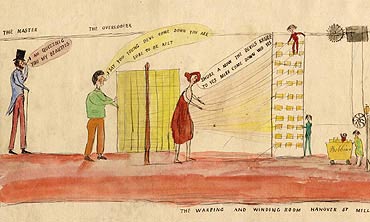
This, the legend at the foot of the image tells us, is ‘THE WARPING AND WINDING ROOM HANOVER ST MILL’ The chap on the left in the top-hat is called ‘THE MASTER’ and he says: ‘I am quizzing you, my beauties’. The fellow in green is ‘THE OVERLOOKER’, and is saying (presumably to the little boy in red who’s shinned up the loom): ‘I say you young devil come down you are sure to be kilt’. And the red-haired woman is saying: ‘Sure a now the devils skure to yes Mike come down wid yes’.
Here’s another, sadly in black and white (you can see the full colour version at the pdf link mentioned above):
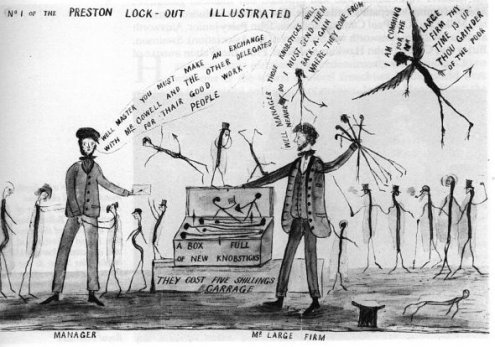
You can see he’s pulling stick-figure workers out of a container labelled ‘a box full of new knobsticks’. Fascinating stuff. Incidentally, I’m not aware of any critical work on this (this fairly well-known article, ‘Dickens, Gaskell and the Preston Strike’, doesn’t mention it, for instance): it might make a nice topic, or at least a nice angle, for a Hard Times essay …) [AR]
Hard Times
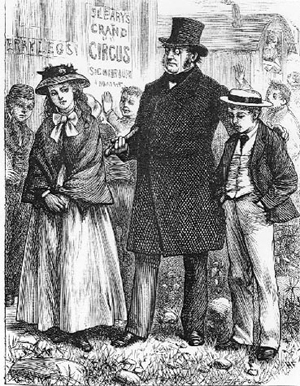
Tomorrow’s novel class (the last before reading week) is on Hard Times, of which novel it is probably fair to say: CD’s contemporaries thought little of it, though Leavis and later critics have loved it! To quote Grahame Smith:
Even in the general climate of disappointment generated by the later, so-called ‘dark’ novels, Hard Times stands out in the meagre response it elicited from Victorian reviewers and in the lack of serious consdieration it had received until the middle of the twentieth-century. It was admired by a great contemporary, John Ruskin, and found a passionate advocate in George Bernard Shaw at a later stage, but it had to wait until 1948 for a full-scale rehabilitation, although of a qualified kind, by F R Leavis in The Great Tradition. Leavis praise the novel for the absence of those very qualities which to many readers have seemed most Dickensian: that is, richness of detail, comic exuberance and an apparently cavalier attitude to the more rigorous aspects of literary form. … Leavis’s revaluation paved the way for later appreciations which have grasped that the intense seriousness of the novel’s critique of its social world is not, in fact, incompatible with the linguistic energy and comic verve that seem so central to Dickens’s achievement. There is exuberance here, too, and although its brevity precludes the large-scale structural complexity of Bleak House and Little Dorrit, the brilliance of Hard Times‘s pared-down language is hardly less impressive in its wit and variety.
Here are a few links that you might find useful, in terms of getting a handle on the novel: you’re not required to read them before class, but they might help. Utilitarianism is usually seen as an important context for Hard Times; as is Industrialism. Dickens claimed he conceived and started writing the novel before the Preston Lock-out, but it’s good to have a sense of what that example of loggerheads industrial relations entailed. Some interesting articles:
That last one picks up on what we were saying in last week’s core course class about metaphor and metonomy … [AR]
On being in love with Steerforth from David Copperfield
Did you know that eminent contemporary philosophy Martha Nussbaum has fallen in love (‘rushing into the eager volatility of desire’) with Steerforth, from David Copperfield? No? Then read this essay, ‘Steerforth’s Arm: Love in the Moral Point of View’ from her celebrated collection Love’s Knowledge: Essays on Philosophy and Literature (1990). [If the link doesn’t work for you, either type ‘Steerforth’s Arm’ into the ‘search this book’ box on the left hand side of the page, or else scroll down and click on the ‘contents’ page at the bottom]. [AR]
Dorrit’s circulations, Gothic economics
Next week’s Dorrit class (on the novel course) will be about ‘circulation’, the circumlocution office not least. With that in mind, I wanted to flag up Gail Turley Houston’s relatively new monograph, From Dickens to Dracula: Gothic, Economics, and Victorian Fiction (Cambridge Univ. Press 2007), a very interesting account of the cultural and ‘Gothic’ economics of Bagehot, Marx, Dickens, Stephenson and Stoker, with others along the way. Much of the book is free to read on Google books: enough, anyway, to get a flavour of her argument. The chapter on Dorrit (‘”The Whole Duty of Man”: Circulating Circulation in Dickens’s Little Dorrit‘) is a particularly fascinating attempt to read the novel via the discourses of capital fluidity and banking. It doesn’t sound fascinating, I accept, when I put it like that; but it is. At least, it gave me a new perspective on the book when I read it. Plus, isn’t this just the coolest cover? I am envious:
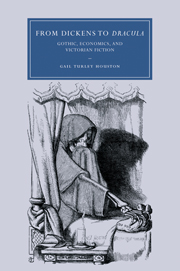
(You’re not required to read this for next week’s class, by the way; but you may find it interesting) [AR]
Little Dorrit and prisons
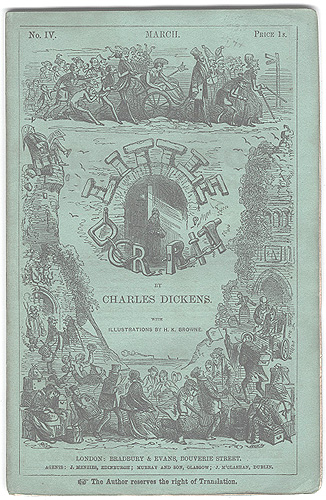
Today’s Novel class, on Little Dorrit, is all about prisons, and the consistently worked-through thematic of imprisonment in the novel. In one sense, nowadays, this may seem an obvious angle on the novel; but in fact it takes its cue from an essay written half a century ago by the American critic Lionel Trilling. Trilling was commissioned to write the introduction to the Oxford Illustrated Dickens; the essay was later reprinted in The Kenyon Review Vol. 15, No. 4 (Autumn, 1953), pp. 577-590 (click that link and you’ll find the whole essay). This, influentially, was Trilling’s reading of the novel:
The subject of Little Dorrit is borne in upon us by the informing symbol, or emblem, of the book, which is the prison. The story opens in a prison in Marseilles. It goes on to the Marshalsea, which in effect it never leaves. The second of the two parts of the novel begins in what we are urged to think of as a sort of prison, the monastery of the Great St Bernard. The Circumlocution Office is the prison of the creative mind of England. Mr Merdle is shown habitually holding himself by the wrist, taking himself into custody, and in scores of ways the theme of incarceration is carried out, persons and classes being imprisoned by their notions of predestined fate or of religious duty, or by their occupations, their life-schemes, their ideas of themselves, their very habits of language.
Symbolic or emblematic devices are used by Dickens to one degree or another in several of the novels of his late period, but nowehere to such good effect as in Little Dorrit. The fog of Bleak House, the dustheap and the river of Our Mutual Friend are very striking, but they scarcely equal the force of the prison image which dominates Little Dorrit. This is because the prison is an actuality before it is ever a symbol; its connection with the will is real, it is the practical instrument for the negation of man’s will which the will of society has contrived.
Trilling later added a footnote: ‘Since writing this I have had to revise my idea of the actuality of the symbols of Our Mutual Friend. Professor Johnson’s biography of Dickens taught me much about the nature of dustheaps, including their monetary value, which was very large … I never quite believed that Dickens was telling the literal truth about this. From Professor Dodd’s The Age of Paradox I have learned to what an extent the Thames was visible the sewer of London, of how pressing was the problem of sewage in the city as Dickens knew it, of how present to the mind was the sensible and even the tangible evidence that the problem was not being solved. The moral disgust of the book is thus seen to be quite adequately comprehended by the symbols which are used to represent it.’ [AR]
MOOR-EEFFOC
This afternoon’s Novel class talked about the relationship between Dickens’ ‘Autobiographical Fragment’ and David Copperfield; I tried to put together an argument about the secret (hidden, paradoxically, in plain view) of shame at the core of Dickens’s imaginative vision, and more specifically about the bodily or somatic quality of that shame: something to do with intimacy, with appetite, predation, physical contact. We also talked about the imaginative logic of ‘inversion’ that Dickens so often deploys, and I made the connection with the ‘dream work’ of Dickens, which often operates via inversion, substitution and transference. We discussed the repulsive physicality of Uriah Heep: as an inverted mirroring of David (both boys trying to get on via hard work, both hoping to marry Agnes etc., but one handsome and appealing the other revolting and despicable). We looked at descriptions of Heep’s physicality, his hideous ‘peeled’ quality, as if he lacked his outer skin, and his hands were mucus membranes. People weren’t persuaded by my the ‘COFFEE ROOM’ inversion in the ‘Fragment’
The coffee shops to which I most resorted were, one in Maiden Lane; one in a court (non-existent now) close to Hungerford Market; and one in St Martin’s Lane, of which I only recollect that it stood near the church, and that in the door there was an oval glass plate with ‘COFFEE ROOM’ painted on it, addressed towards the street. If I ever find myself in a very different kind of coffee-room now, but where there is an inscription on glass, and read it backwards on the wrong side, MOOR EEFFOC (as I often used to do then in a dismal reverie), a shock goes through my blood. [Forster, Life of Dickens, I:ii, ‘Hard Experiences in Boyhood 1822-4‘]
… but, to get to my point: I mentioned, I think, that this came up last year. And here is the link to the blog post from last year, where this is discussed a little more. [AR]